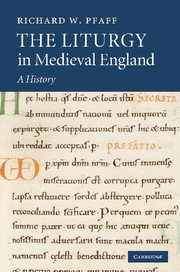Book contents
- Frontmatter
- Contents
- Preface
- Sigla and editorial conventions
- Bibliographical abbreviations
- Nicknames for manuscripts frequently referred to
- 1 Introduction
- Excursus: on sources
- 2 Early Anglo-Saxon England: a partly traceable story
- Excursus: on the terms Gregorian and Gelasian as used here
- 3 Later Anglo-Saxon: liturgy for England
- 4 The Norman Conquest: cross fertilizations
- Excursus: on method in the comparison of liturgical texts
- 5 Monastic liturgy, 1100–1215
- Excursus: on ascription of liturgical books to specific churches
- 6 Benedictine liturgy after 1215
- 7 Other monastic orders
- 8 The non-monastic religious orders: canons regular
- 9 The non-monastic religious orders: friars
- Excursus: on liturgical books from female religious houses
- 10 Old Sarum: the beginnings of Sarum Use
- 11 New Sarum and the spread of Sarum Use
- 12 Exeter: the fullness of secular liturgy
- 13 Southern England: final Sarum Use
- 14 Regional Uses and local variety
- 15 Towards the end of the story
- Index of Manuscripts
- Index of Saints
- General Index
Excursus: on the terms Gregorian and Gelasian as used here
Published online by Cambridge University Press: 20 March 2010
- Frontmatter
- Contents
- Preface
- Sigla and editorial conventions
- Bibliographical abbreviations
- Nicknames for manuscripts frequently referred to
- 1 Introduction
- Excursus: on sources
- 2 Early Anglo-Saxon England: a partly traceable story
- Excursus: on the terms Gregorian and Gelasian as used here
- 3 Later Anglo-Saxon: liturgy for England
- 4 The Norman Conquest: cross fertilizations
- Excursus: on method in the comparison of liturgical texts
- 5 Monastic liturgy, 1100–1215
- Excursus: on ascription of liturgical books to specific churches
- 6 Benedictine liturgy after 1215
- 7 Other monastic orders
- 8 The non-monastic religious orders: canons regular
- 9 The non-monastic religious orders: friars
- Excursus: on liturgical books from female religious houses
- 10 Old Sarum: the beginnings of Sarum Use
- 11 New Sarum and the spread of Sarum Use
- 12 Exeter: the fullness of secular liturgy
- 13 Southern England: final Sarum Use
- 14 Regional Uses and local variety
- 15 Towards the end of the story
- Index of Manuscripts
- Index of Saints
- General Index
Summary
The Gregorian books are so named, since at least the time of Charlemagne, after the pope whose pontificate (590–604) provides our precise starting point, Gregory I – which does not necessarily mean, of course, that he had anything do to with the actual construction of such books – and represent a basically papal tradition: in theory, for the liturgy of the mass as celebrated by the pope in Rome. Whatever earlier nuclei there may have been, perhaps going back to the pontificate of Honorius I (625–38), no form of a Gregorian massbook seems to be recoverable, even by extrapolation, until early in the last quarter of the seventh century, c. 675: the one known as Paduensis. The best known Gregorian book, moreover, dates from roughly a century later: the Hadrianum, named from Pope Hadrian I, who in about 790 sent such a book to Frankland at the request of Charlemagne. Not adequate to that ruler's grand hopes and purposes, it was soon furnished with an extensive Supplement, confected by either Alcuin or (more likely) Benedict of Aniane; this is signalled by a celebrated preface always referred to by its opening word, Hucusque. The Hadrianum itself has not survived, but several copies do: the earliest, made around 812, at Cambrai. Further copies proliferated and ramified throughout the ninth and tenth centuries, and these, intermixed with Gelasian elements, eventually become the main stock of Roman-derived massbooks throughout northern Europe, including England.
- Type
- Chapter
- Information
- The Liturgy in Medieval EnglandA History, pp. 56 - 61Publisher: Cambridge University PressPrint publication year: 2009



